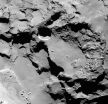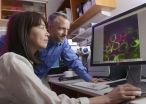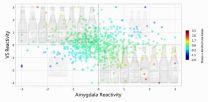(Press-News.org) There may be far fewer galaxies further out in the universe then might be expected, according to a new study led by Michigan State University.
Over the years, the Hubble Space Telescope has allowed astronomers to look deep into the universe. The long view stirred theories of untold thousands of distant, faint galaxies. The new research, appearing in the current issue of the Astrophysical Journal Letters, however, offers a theory that reduces the estimated number of the most distant galaxies by 10 to 100 times.
"Our work suggests that there are far fewer faint galaxies than we once previously thought," said Brian O'Shea, MSU associate professor of physics and astronomy. "Earlier estimates placed the number of faint galaxies in the early universe to be hundreds or thousands of times larger than the few bright galaxies that we can actually see with the Hubble Space Telescope. We now think that number could be closer to ten times larger.
O'Shea and his team used the National Science Foundation's Blue Waters supercomputer to run simulations to examine the formation of galaxies in the early universe. The team simulated thousands of galaxies at a time, including the galaxies' interactions through gravity or radiation.
The simulated galaxies were consistent with observed distant galaxies at the bright end of the distribution - in other words, those that have been discovered and confirmed. The simulations didn't, however, reveal an exponentially growing number of faint galaxies, as has been previously predicted. The number of those at the lower end of the brightness distribution was flat rather than increasing sharply, O'Shea added.
These simulations will be tested further when the much-anticipated James Webb Space Telescope comes online in late 2018. The improved technology will afford astronomers even more-detailed views of space than the amazing images that the Hubble has produced in recent years.
The Hubble Space Telescope can see the tip of the iceberg of the most-distant galaxies, said Michael Norman, co-author of the paper and director of the San Diego Supercomputer Center at the University of California, San Diego.
While the James Webb telescope will improve views of distant galaxies, the telescope has a relatively small field of view. As a result, the observations must take into account cosmic variance - the statistical variation in the number of galaxies from place to place.
That's what makes these simulations pertinent even as improved technology becomes available, O'Shea said.
"A deeper understanding based on theory may be necessary to correctly interpret what's being seen, such as high redshift survey results," he said.
INFORMATION:
In addition to O'Shea and Norman, the research team also included John Wise, an assistant professor at the Georgia Institute of Technology, and Hao Xu, a postdoctoral research associate at the University of California, San Diego.
The research was funded by the National Science Foundation and NASA.
People have evolved to be smarter and taller than their predecessors, a study of populations around the world suggests.
Those who are born to parents from diverse genetic backgrounds tend to be taller and have sharper thinking skills than others, the major international study has found.
Researchers analysed health and genetic information from more than 100 studies carried out around the world. These included details on more than 350,000 people from urban and rural communities.
The team found that greater genetic diversity is linked to increased height. It is also ...
The European Space Agency's Rosetta spacecraft first began orbiting comet 67P/Churyumov-Gerasimenko in August 2014. Almost immediately, scientists began to wonder about several surprisingly deep, almost perfectly circular pits on the comet's surface. Now, a new study based on close-up imagery taken by Rosetta suggests that these pits are sinkholes, formed when ices beneath the comet's surface sublimate, or turn directly to gas.
The study, which appears in the July 2, 2015 issue of the journal Nature, reveals that the surface of 67P/Churyumov-Gerasimenko is variable and ...
DALLAS - July 1, 2015 - UT Southwestern Medical Center scientists collaborating with University of Michigan researchers have found a previously unidentified mechanism that helps explain why stem cells undergo self-renewing divisions but their offspring do not.
Adult stem cells provide a ready supply of new cells needed for tissue homeostasis throughout the life of an organism. Specialized environments called "niches" help to maintain stem cells in an undifferentiated and self-renewing state. Cells that comprise the niche produce signals and growth factors essential for ...
DURHAM, N.C. - A pair of brain-imaging studies suggest researchers may be able to predict how likely young adults are to develop problem drinking or engage in risky sexual behavior in response to stress.
The new research is part of the ongoing Duke Neurogenetics Study (DNS), which began in 2010 to better understand how interactions between the brain, genome and environment shape risky behaviors that can predict mental illnesses including depression, anxiety, and addiction.
"By knowing the biology that predicts risk, we hope to eventually change the biology -- or at ...
GeoSpace
Beijing quadrupled in size in a decade, new study finds
Researchers tracked the changing physical infrastructure in Beijing, China, and found that the city's physical area quadrupled between 2000 and 2009, according to a new study published in Journal of Geophysical Research: Atmospheres.
Eos.org
Seismic Hazard Assessment: Honing the Debate, Testing the Models
Earthquake experts learn that "take a hike" isn't an insult, but a way to resolve hotly debated scientific issues. The scientists found common ground by trekking over it.
New research papers
Disappearance ...
For decades, researchers in the genetics field have theorized that the protein spools around which DNA is wound, histones, remain constant in the brain, never changing after development in the womb. Now, researchers from the Icahn School of Medicine at Mount Sinai have discovered that histones are steadily replaced in brain cells throughout life - a process which helps to switch genes on and off. This histone replacement, known as turnover, enables our genetic machinery to adapt to our environment by prompting gene expression, the conversion of genes into the proteins that ...
Washington, D.C., July 1, 2015--The vast majority of consumers recognize that multivitamins, calcium and/or vitamin D supplements can help fill nutrient gaps but should not be viewed as replacements for a healthy diet, according to a new survey conducted on behalf of the Council for Responsible Nutrition (CRN). Conclusions from the survey of more than 2,000 U.S. adults were published in Nutrition Journal in a peer-reviewed article titled, "Consumer attitudes about the role of multivitamins and other dietary supplements: report of a survey," authored by CRN consultant Annette ...
Neurons in a brain region called the medial temporal lobe play a key role in our ability to quickly form memories about real-life events and experiences, according to a study published July 1st in Neuron. By recording from individual neurons in patients, the researchers reveal for the first time in humans the single-cell basis for the creation of episodic memories.
"It was impressive to see how individual neurons signalled the learning of new contextual associations between people and places and that the changes in firing could occur just after one instance," says lead ...
The brain region that helps people tell whether an object is near or far may also guide how emotionally close they feel to others and how they rank them socially, according to a study conducted at the Icahn School of Medicine at Mount Sinai and published today in the journal Neuron. The findings promise to yield new insights into the social deficits that accompany psychiatric disorders like schizophrenia and depression.
The study focused on evidence for the existence of a "social map" in the hippocampus, the part of the brain that remembers locations in physical space ...
If your eyes deceive you, blame your brain. Many optical illusions work because what we see clashes with what we expect to see.
That 3D movie? Give credit to filmmakers who exploit binocular vision, or the way the brain merges the slightly different images from the two eyes to create depth.
These are examples of the brain making sense of the information coming from the eyes in order to produce what we "see." The brain combines signals that reach your retina with the models your brain has learned to predict what to expect when you move through the world. Your brain solves ...



